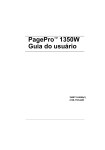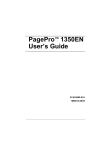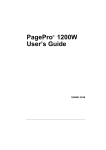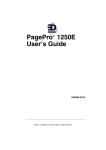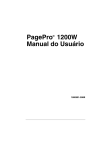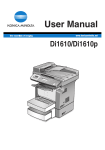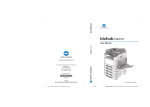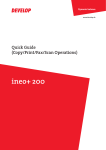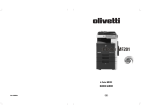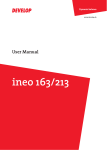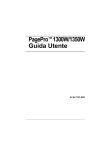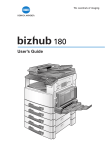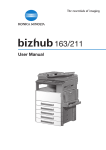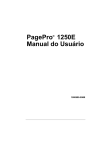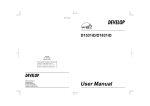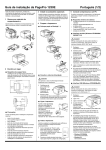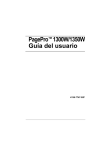Download 4 - Printers - Konica Minolta
Transcript
PagePro™ 1300W/1350W User’s Guide 4136-7747-02A Contents 1 Introduction ....................................................................................................... 1 Getting Acquainted with Your Printer 2 Printer Parts 2 Front View 2 Rear View 2 About the Indicator Functions 3 Indicator Functions 3 Continuing a Print Job after an Error Message 3 Cancelling a Print Job 3 Status Message 4 2 Software Installation ......................................................................................... 7 Installing the USB Device Driver 8 Installing the USB Device Driver under Windows Me and 98 8 Installing the Printer Driver 9 Installing from the CD-ROM 9 3 Working with the Printer Driver ..................................................................... 11 Displaying Printer Driver Settings 12 Displaying Settings under Windows XP 12 Contents i Displaying Settings under Windows 2000/Me/98 Using the Printer Driver 13 Common Buttons 13 OK 13 Cancel 13 Apply 13 Help 13 Easy Set 13 Page Layout 13 Printer Figure 13 Setup Tab 14 Paper Tab 14 Quality Tab 14 Device Options Setting Tab 14 12 4 Working with the Status Display ....................................................................15 Working with the Status Display 16 Introduction 16 Environment 16 Opening the Status Display and Showing the Supplies Status 16 Altering the Size of the Status Display Window 16 Using the Status Display 16 Recognizing Status Display Alerts 17 Recovering from a Status Display Alert 17 Closing the Status Display 18 5 Using Media .....................................................................................................19 About Media 20 What sizes/weights of media can I use? 20 What type and amount of media can I load? 21 Media Storage 21 Media Not Suitable for Printing 22 What Is the guaranteed imageable (printable) area? 23 Page Margins 23 Loading Media 24 How do I refill Tray 1? 24 Printing on Media 25 How do I load and print custom media? 25 How do I load and print envelopes? 25 How do I load and print labels? 27 How do I load and print postcards? 28 How do I load and print thick stock? 29 How do I load and print transparencies? 30 Manual Duplexing 31 How do I manually duplex? 31 ii Contents 6 Replacing Consumables ................................................................................ 33 Replacing the Toner Cartridge 35 Replacing the Drum Cartridge 40 7 Maintaining the Printer ................................................................................... 45 Cleaning the Printer 46 Exterior 46 Pick-up Roller 47 8 Troubleshooting .............................................................................................. 49 Indicator Messages 50 Error Messages 50 Service Messages 51 Clearing Jams 52 Solving Problems-Printing Quality 55 A Appendix .......................................................................................................... 59 Safety Specifications 60 Technical Specifications 60 Printer 60 Parallel Interface Connectors and Cable 62 USB Interface Connectors and Cable 62 Consumables Life Expectancies Chart 62 Our Concern for Environmental Protection 63 What is an ENERGY STAR product? 63 CE Marking (Declaration of Conformity) 63 For European Users 63 CISPR 22 and Local Rules 63 Acoustic Noise 64 Safety Information 64 Warning and Precaution Symbols 64 Meaning of Symbols 64 WARNING 65 CAUTION 67 Working Safely with your Laser Printer 68 Notes on your Safety and Operating Safety 68 Laser Safety 70 Internal Laser Radiation 70 Laser Safety Label 71 For United States Users 71 For Users in All Countries 72 For Denmark Users 72 For Norway Users 72 For Finland, Sweden Users 72 Contents iii iv Contents Introduction Getting Acquainted with Your Printer Printer Parts The following drawings illustrate the parts of your printer referred to throughout this guide, so please take some time to become familiar with them. Front View 1 2 1—Top cover 3 2—Output tray 4 3—Control panel 4—Imaging cartridge (Toner cartridge plus Drum cartridge) 5 5—Front cover 6—Tray 1 6 11 7—Front cover grip 10 9 8 7 8—Paper guide stopper 9—Paper guides 10—Ventilation grilles Drum cartridge Imaging cartridge 11—Power switch Toner cartridge Rear View 1—AC power connection 2—Parallel port 3—USB port 3 1 2 2 Getting Acquainted with Your Printer About the Indicator Functions Indicator Functions The control panel has two indicators and one button. The control panel indicators provide information on the status of the printer. 1—Ready indicator 2—Error indicator 1 2 3—Cancel button The Cancel button allows you to: 3 Continue a print job after an error message Cancel a print job Continuing a Print Job after an Error Message You can continue the print job after correcting the following types of errors: When the print job is too complex and the memory capacity of the printer is inadequate When there is no more paper in the tray When paper of a different format than that set in the printer driver was fed 1 2 3 into the printer Check that one of the above errors has occurred. Perform the remedial action according to the error. Press the Cancel button to operate the media feed. The print job continues. For details on the error messages, refer to chapter 8, “Troubleshooting” on page 49. Cancelling a Print Job You can cancel a print job that is currently being processed. 1 2 While data is being processed or printed (the green “Ready” indicator is blinking), hold down the Cancel button for more than 5 seconds. Release the Cancel button after both indicators light up. The current print job has now been cancelled. About the Indicator Functions 3 The indicators may show five types of signals: Off On Slow blinking—1 blink every 2 seconds Blinking—1 blink per second Rapid blinking—2 blinks per second Status Message Status messages indicate the current condition of the printer. The printer status also can be checked on the Status Display. (Refer to the “Working with the Status Display” on page 16.) Ready indicator (green) Error indicator (orange) Condition Action Off Off Power off None On Off Ready to print None Rapid blinking Off Warming up None Blinking Off Processing data None On On Initializing (power on) Printing None Canceling a print job Slow blinking Off 4 Power save mode None About the Indicator Functions Ready indicator (green) Error indicator (orange) Condition Action On Slow blinking Toner near empty Prepare the new toner cartridge. On Blinking Toner empty Replace the toner cartridge. On Rapid blinking Toner cartridge end Replace the toner cartridge. No toner cartridge is installed. Install the toner cartridge. The installed toner car- Install a tridge is an unapKONICA MINOLTA proved type. toner cartridge. Note If a toner cartridge for a different region, an unapproved toner cartridge, or a toner cartridge that is at the end of its life is used, cleaning will be performed after each page is printed, which will reduce the printing speed. About the Indicator Functions 5 6 About the Indicator Functions Software Installation Installing the USB Device Driver When connecting the printer to your computer with a USB cable, install the USB device driver according to the following instructions before installing the printer driver. Note In Windows 2000/XP, you do not have to install the USB device driver. When the “Found New Hardware” wizard dialog box appears, cancel it. Installing the USB Device Driver under Windows Me and 98 1 2 3 4 Turn on your computer. Turn on the printer. When Windows and the printer are both ready, insert the CD-ROM, included with your printer, into your computer’s CD-ROM drive. Connect the printer to the computer with the USB cable. The Add New Hardware Wizard dialog box appears. Follow the instructions on the screen. " 5 6 8 Browse the printer driver CD-ROM and navigate to: “drivers\English\Win9x” (for Windows Me and 98). Click Finish. This completes the installation of the USB device driver. When the Add New Hardware Wizard dialog box appears after clicking Finish, click Cancel. Installing the USB Device Driver Installing the Printer Driver Note Do not use the “Found New Hardware” or “Add New Hardware” wizard to install the PagePro 1300W/PagePro 1350W driver and utilities. Installing from the CD-ROM 1 2 Insert the CD-ROM in the CD-ROM drive of your computer. The CD-ROM installer automatically starts. If not , browse with the Windows Explorer to the CD-ROM and double-click on setup.exe. Follow the instructions on the screen. " For a USB connection, select “USBxxx” as the printer port. For a Parallel connection, select “LPTx” as the printer port. Installing the Printer Driver 9 10 Installing the Printer Driver Working with the Printer Driver Displaying Printer Driver Settings Displaying Settings under Windows XP 1 2 3 4 5 From the Start menu, click Control Panel. In Pick a category, click Printers and Other Hardware. In Pick a task…, click View installed printers or fax printers. In the Printers and Faxes directory, select the KONICA MINOLTA PagePro 1300W/PagePro 1350W printer icon. To display the printer driver settings, from the File menu, click Printing Preferences.... Displaying Settings under Windows 2000/Me/98 1 2 3 From the Start menu, point to Settings, and then click Printers to display the Printers directory. Select the KONICA MINOLTA PagePro 1300W/PagePro 1350W printer icon. Display the printer driver settings: Windows 2000—From the File menu, click Printing Preferences.... Windows Me/98—From the File menu, click Properties, and then click the Printer Properties tab. 12 Displaying Printer Driver Settings Using the Printer Driver " Refer to the printer drivers online help for information on all of the functions. Common Buttons The buttons described below appear on each tab. OK Click to exit the Properties dialog box, saving any changes made. Cancel Click to exit the Properties dialog box without saving any changes made. Apply Click to save all changes without exiting the Properties dialog box. Help Click to view online help. Easy Set To save the current settings, click Save.... Afterward, the saved settings can be selected from the drop-down list. Select Default from the drop-down list to reset the functions of the tab to their original values. Page Layout Check this option button to display a sample of the page layout in the figure area. Printer Figure Check this option button to display an image of the printer in the figure area. Using the Printer Driver 13 Setup Tab The Setup tab allows you to Print several pages of a document on the same page (n-up printing) Provide a watermark on printed documents Design custom watermarks Specify manual duplex printing Specify the paper source Define the type of media Print using a form overlay Create/edit a form overlay Paper Tab The Paper tab allows you to Specify the size of the original document Define custom media sizes Fit printed documents to a specified media size Select the output media size Scale (enlarge/reduce) documents Adjust the printing position Specify the number of copies Turn on/off the printer’s sorting function Turn on/off the Proof Print function Specify the orientation of the media Rotate the print image 180° to the media orientation Quality Tab The Quality tab allows you to Specify the resolution Adjust the contrast and brightness of the printed document Turn on/off Toner Save mode Device Options Setting Tab The Device Options Setting tab allows you to View version and copyright information about the printer driver 14 Using the Printer Driver Working with the Status Display Working with the Status Display Introduction The Status Monitor shows information about the current status of the computer’s local printer. Environment The Status Display can be used with Windows XP, 2000, Me, and 98 connected via a parallel cable or USB cable. Opening the Status Display and Showing the Supplies Status Use one of the following steps to open the Status Display. Windows XP—Choose Start, All Programs, then KONICA MINOLTA PagePro 1300W/PagePro 1350W Utilities, and then KONICA MINOLTA PagePro 1300W/PagePro 1350W Status. Windows Me/2000/98—From the Start menu, choose Programs, then KONICA MINOLTA PagePro 1300W/PagePro 1350W Utilities, and then KONICA MINOLTA PagePro 1300W/PagePro 1350W Status. Altering the Size of the Status Display Window From the Display menu, choose Status (Reduce) to decrease the size of the window, or From the Display menu, choose Status (Expand) to increase the size of the window. Using the Status Display When the background of the right-hand printer graphic is green, the printer is in standby mode or a job is printing normally. When the background of the right-hand printer graphic is red, there is an error and the job has been interrupted. The status of the printer and the error message are shown in the dialog boxes on the left. The function areas include: Printer status—Displays text messages that describe the current operational status of the printer. How to recover—Provides you with explanations of what you need to do in order to correct problems and recover from error conditions. 16 Working with the Status Display Warning status—Displays text messages that alerts you of such conditions as low toner. Printer status figure—Shows a graphic representation of the printer and indicates where the problem is. Printing status—Displays the status of the current print job. Select popup message—Allows you to choose which message(s) you want to bring to the foreground when that particular condition occurs with the printer. Maintenance—Allows you to specify the Midnight Mode functions and Auto Continue functions. Supplies status—Displays consumables usage statuses (percentage remaining) of the toner cartridge. Refer to the online help for information on all of its functions. Recognizing Status Display Alerts When the Status Display detects a printing problem, several actions occur at the same time, depending on your settings. First, the icon changes from green to yellow or red, depending on the severity of the printer problem. Refer to the online help for further information on these settings. Recovering from a Status Display Alert When the Status Display notifies you of a printing problem, double-click on its icon to open the Status Display. The Status Display identifies which printer has an error and what type of error has occurred. Refer to the online help for further information on these settings. Recognizing Status Display Alerts 17 Closing the Status Display To close the Status Display from the File menu, choose Exit. " 18 If you click the X button in the upper-right corner of the Status Display window to close the window, the Status Display remains available at the bottom right of the taskbar. Double-click the icon to open it again. Closing the Status Display Using Media About Media What sizes/weights of media can I use? Media Media Size Millimeters Inches A4 210.0 × 297.0 8.2 × 11.7 B5 (JIS) 182.0 × 257.0 7.2 × 10.1 A5 148.0 × 210.0 5.9 × 8.3 Legal 215.9 × 355.6 8.5 × 14.0 Letter 215.9 × 279.4 8.5 × 11.0 Statement 140.0 × 216.0 5.5 × 8.5 Executive 184.0 × 267.0 7.25 × 10.5 Folio 210 × 330.0 8.25 × 13.0 Letter Plus 216 × 322 8.5 × 12.69 UK Quarto 203 × 254 8 × 10 Foolscap 203 × 330 8 × 13 G. Letter 203 × 267.0 8 × 10.5 G. Legal 216 × 330 8 1/2 × 13 Chinese 16 185.0 × 260.0 7.3 × 10.2 Chinese 32 130.0 × 185.0 5.1 × 7.3 16K 195 × 270 7 3/4 × 10 3/4 B5 (ISO) 176.0 × 250.0 6.6 × 9.8 Envelope #10 105 × 241 4.125 × 9.5 Envelope C5 162.0 × 229.0 6.4 × 9.0 Envelope DL 110.0 × 220.0 4.3 × 8.7 N/A Envelope Monarch 98.0 × 191.0 3.875 × 7.5 Envelope C6 114.0 × 162.0 4.5 × 6.4 60–90 g/m² (16–24 lb) Envelope Cho #3 120 × 235 4 3/4 × 9 1/4 Envelope Cho #4 90 × 205 3 1/2 × 8 Japanese Postcard 100.0 × 148.0 3.9 × 5.8 Double Postcard 148 × 200 5 3/4 × 7 3/4 Thick stock 20 Weights 60–90 g/m² (16–24 lb) N/A 91–163g/m² (25–43 lb) About Media What type and amount of media can I load? Media Source/Maximum Amount Media Type Input Capacity Tray 1 Plain Paper 60–90 g/m (16–24 lb) 150 sheets Special Media Envelopes 10 sheets Label sheets 10 sheets Letter head 10 sheets Postcards (Japanese Size) 50 sheets (first face) 2 20 sheets (second face) Thick paper 91–163 g/m (24–90 lb) 10 sheets Transparencies 5 sheets 2 Note Do not allow media to go above the fill limit mark inside the tray or the media may not be fed correctly. Media Storage Keep media on a flat, level surface in its original wrapper until it is time to load it. If media has been removed from its wrapper, place it in its original packaging and store in a cool, dark place. When storing media, avoid Moisture, excess humidity Keep media between 30% to 65% relative humidity. Toner does not adhere well to moist or wet paper On the other hand, media that has been stored for a long time without staying in its packaging may dry up too much and also cause jamming. Direct sunlight Excess heat (up to 35°C/95°F) Dust Leaning against other objects or placed in an upright position Before purchasing a large quantity or special media, do a trial printing with the same media and check the print quality. About Media 21 Media Not Suitable for Printing Note Do not use the media types listed below. These could cause poor print quality, media jams, or damage to the printer. Also, using them will void your warranty. Coated with a processed surface (such as carbon paper, digitally glosscoated media, colored paper that has been treated) Carbon backed Iron-on transfer media (heat-sensitive paper, heat-pressure paper, heat-press transfer paper) Cold water transfer paper Pressure sensitive Special media designed specifically for inkjet printers (superfine paper, glossy paper, glossy film, postcards, etc.) Media that has already been printed with – – – – An inkjet printer A monochrome or color laser printer or copier A heat-transfer printer Another printer or fax machine Wet (or damp) Layered Adhesive Folded, creased, curled, embossed, warped, or wrinkled Perforated, three-hole punched, or torn Too slick, too coarse, too textured Different in texture (roughness) on the front and back Too thin or too thick Stuck together because of static electricity Composed of foil or gilt; too luminous Heat sensitive or cannot withstand the fusing temperature (205°C/401°F) Irregularly shaped (not rectangular or not cut at right angles) Attached with glue, tape, paper clips, staples, ribbons, hooks, or buttons Acidic Any other media that is not approved 22 About Media Use media that is Suitable for plain-paper laser printers, such as standard paper What Is the guaranteed imageable (printable) area? Each media size has a specific imageable area, the maximum area on which the printer can print clearly and without distortion. 4 mm (0.157 in.) 4 mm (0.157 in.) 4 mm (0.157 in.) 4 mm (0.157 in.) Page Margins Margins are set through your application. Some applications allow you to set custom page sizes and margins while others have only standard page sizes and margins from which to choose. If you choose a standard format, you may lose part of your image (due to imageable area constraints). If you can custom-size your page in your application, use those sizes given for the imageable area for optimum results. About Media 23 Loading Media How do I refill Tray 1? " 1 2 Refill the tray only when it is completely empty. Squeeze the right paper guide and open the paper guides. Load the media lengthwise and printing-side up in the tray. A maximum of 150 sheets (75 g/m2 [20 lb] plain paper) can be loaded. If media is loaded past the media limit mark, it may not be fed correctly. 3 24 Load letterhead with the side to be printed facing up and the preprinted letterhead at the top (facing the printer). Squeeze the right paper guide and adjust the paper guides so that both the left and right sides of the media are secure. Loading Media Printing on Media How do I load and print custom media? Do not use custom media that does not have approved dimensions Width: 76 mm (3 in.) up to 216 mm (8.5 in.) Length: 127 mm (5 in.) up to 356 mm (14 in.) 1 2 3 4 In the printer driver (Setup tab/Media Type option), select plain paper. Set the media size (Paper tab/Original Document Size/Edit Custom...) Load the custom media lengthwise and printing-side up in Tray 1. Adjust the paper guides to the width of the custom media. Note Improperly adjusted guides may cause poor print quality, media jams, or printer damage. 5 Print the custom media. How do I load and print envelopes? " Before printing on envelopes, we recommend printing a test page. If the print result is not oriented as desired, select Rotated (Paper tab/ Orientation option). Do not use envelopes that have Sticky flaps Tape seals, metal objects, paper clips, fasteners, or peel-off strips for sealing Transparent windows Rough surface Material that will melt, vaporize, or emit dangerous fumes Been presealed Printing on Media 25 Use envelopes that are Common office envelopes with diagonal joints, sharp folds and edges, and ordinary gummed flaps Approved for laser printing Dry 1 2 3 4 5 6 7 26 In the printer driver (Setup tab/Media Type option), select Envelope. Select the size of the envelope (Paper tab/Original Document Size option). Place the envelopes on a flat surface, and flatten them by pressing down the corners. Flex the envelope stack (including the edges) to remove any stiffness. Correct any bent corners, and tap the envelopes on a flat surface to align them. Squeeze the right paper guide and open the paper guides. Load the envelopes lengthwise and the printing-side up as shown in the illustrations. Printing on Media Note Print envelopes on the front address side only. Some parts of the envelope consist of three layers of paper—the front, back, and flap. Anything printed in these layered regions may be lost or faded. 8 Recheck the paper guides to make sure they are adjusted to the width of the envelopes. Note Improperly adjusted guides may cause poor print quality, media jams, or printer damage. 9 10 Print the envelopes. Open the flap of each envelope immediately (before it cools) after the envelope is delivered to the output tray. " Because the envelopes pass through heated rollers, the gummed area on the flaps may seal. Using envelopes with emulsion-based glue avoids this problem. How do I load and print labels? A label consists of a face sheet (the printing surface), adhesive, and a carrier sheet: The face sheet must follow the plain paper specification. The face sheet surface must cover the entire carrier sheet, and no adhesive should come through on the surface. You can print continuously with label paper. However, this could affect the media feed, depending on the media quality and printing environment. If problems occur, stop the continuous print and print one sheet at a time. Format label data within your application. Try printing your data on a plain sheet of paper first to check placement. Check your application documentation for other information on printing labels. Do not use label sheets that Have labels that easily peel off Labels may stick to the fuser, causing them to peel off and media jams to occur. Printing on Media 27 Are precut OK to use Do not use Full page labels (uncut) Use label sheets that are Recommended for laser printers 1 2 3 4 In the printer driver (Setup tab/Media Type option), select Thick Paper. Select the size of the label (Paper tab/Original Document Size option). Load the label media lengthwise and printing-side up in Tray 1. Adjust the paper guides to the width of the label media. Note Improperly adjusted guides may cause poor print quality, media jams, or printer damage. 5 Print the labels. How do I load and print postcards? Do not use postcards that are Coated Warped or bent Designed for inkjet printers Multicolored Preprinted or multicolored (may result in printer jamming) Use postcards that are Postcards (100 × 148 mm/3.9 × 5.8 in.) recommended for laser printers 1 2 28 In the printer driver (Setup tab/Media Type option), select Postcard. Select the size of the postcard (Paper tab/Original Document Size option). Printing on Media 3 4 5 6 Place the postcards on a flat surface, and flatten them by pressing down the corners. Remove any media in Tray 1. Load the postcard media lengthwise and printing-side up in Tray 1. Adjust the paper guides to the width of the postcards. Note Improperly adjusted guides may cause poor print quality, media jams, or printer damage. 7 Print the postcards. How do I load and print thick stock? Test all thick stock to ensure acceptable performance and to ensure that the image does not shift. Do not use thick stock that is Mixed with any other media in the media trays (as this will cause printer jamming) Note Do not mix thick stock with any other media in the same tray, as this will cause printer jamming. 1 2 3 4 In the printer driver (Setup tab/Media Type option), select Thick Paper. Select the size of the stock (Paper tab/Original Document Size option). Load the thick stock media lengthwise and printing-side up in Tray 1. Adjust the paper guides to the width of the thick stock. Note Improperly adjusted guides may cause poor print quality, media jams, or printer damage. 5 Print the thick stock. Printing on Media 29 How do I load and print transparencies? Note Using unsupported transparency media such as coated color transparencies will result in damaging the printer and in voiding your warranty. Remove transparency media as soon as possible from the output tray to avoid static buildup. If you touch the face of transparencies with your bare hands, print quality may be affected. Do not handle transparency media too much. You can print continuously with transparencies. However, this could affect the media feed, depending on the media quality, static buildup, and printing environment. If you have problems loading a large number of transparencies at a time, try loading only 1–10 sheets. Do not use transparencies that Are coated, such as transparencies designed for color printers or copiers Have static electricity that will cause them to stick together Use transparencies that are Monochrome, uncoated transparencies (also known as OHP film) 1 2 3 In the printer driver (Setup tab/Media Type option) select Transparency. Select the size of the transparency (Paper tab/Original Document Size option). Fan a few transparencies. " 4 5 Fanning a large number will build up static electricity. Load the transparency media lengthwise and printing-side up in Tray 1. Adjust the paper guides to the width of the transparencies. Note Improperly adjusted guides may cause poor print quality, media jams, or printer damage. 6 7 30 Print the transparencies. Immediately remove the printed transparencies from the output tray. Printing on Media Manual Duplexing Select paper with high opacity for duplex (2-sided) printing. For best results, print a small quantity to make sure the opacity is acceptable. How do I manually duplex? " 1 2 3 4 Media jams may occur if the printed sheet(s) reinserted are not entirely flat. In the printer driver (Setup tab/Duplex/Booklet option), select the appropriate setting from Short Edge Binding, Long Edge Binding, Booklet Left Binding, or Booklet Right Binding. From the print dialog box of your software, select the necessary settings and print all pages. Remove the single-sided printouts from the output tray, and then insert them into Tray 1 with the same orientation that they were fed out. Click Proceed on the screen of your PC or press the Cancel button. Manual Duplexing 31 32 Manual Duplexing Replacing Consumables When replacing a toner cartridge, refer to the following table. For optimum print quality and performance, use only approved KONICA MINOLTA toner cartridges for your specific printer type, as listed in the table below. If you open the front cover, you can find your printer type and the toner cartridge part numbers on the consumables reorder label inside the front cover of your printer. For PagePro 1300W Printer Type Printer Part Number Toner Cartridge Type Toner Cartridge Part Number EU 5250216-200 Standard-Capacity Toner Cartridge 1710566-002 5250216-400 High-Capacity Toner Cartridge 1710567-002 5250216-350 Standard-Capacity Toner Cartridge 1710566-003 5250216-600 High-Capacity Toner Cartridge 1710567-003 5250216-300 Standard-Capacity Toner Cartridge 1710566-004 High-Capacity Toner Cartridge 1710567-004 AP, GC JP For PagePro 1350W Printer Type Printer Part Number Toner Cartridge Type Toner Cartridge Part Number AM 5250217-100 Standard-Capacity Toner Cartridge 1710566-001 EU AP, GC JP High-Capacity Toner Cartridge 1710567-001 5250217-200 Standard-Capacity Toner Cartridge 1710566-002 5250217-400 High-Capacity Toner Cartridge 1710567-002 5250217-350 Standard-Capacity Toner Cartridge 1710566-003 5250217-600 High-Capacity Toner Cartridge 1710567-003 5250217-300 Standard-Capacity Toner Cartridge 1710566-004 High-Capacity Toner Cartridge 1710567-004 Note If the toner cartridge for a different region or an unapproved toner cartridge or a toner cartridge that is at the end of its life is used, cleaning will be performed after each page printed, which will reduce the printing speed. 34 Replacing the Toner Cartridge When it is time to replace the toner cartridge, "Toner Low" displays in the Status Display. The supplies status indication in the Status Display is only a reference. Printing can continue even though the warning appears. However, printing gradually fades out, so replace the toner cartridge as soon as possible. " In this manual, a toner cartridge attached to a drum cartridge is referred to as an imaging cartridge. Drum cartridge Imaging cartridge Toner cartridge 1 2 Grab the front cover grip and open the front cover. Pull the handle of the imaging cartridge toward you, and then pull out the imaging cartridge. Note Do not expose the imaging cartridge to light for a long period of time. If the drum cartridge is exposed to light, decreased image quality may result. Replacing the Toner Cartridge 35 3 4 Move the lever on the toner cartridge in the direction of the arrow. Using both hands, separate the toner cartridge and drum cartridge. Toner cartridge Drum cartridge 36 Replacing the Toner Cartridge Note When separating the toner cartridge and drum cartridge, keep them level. Do not touch the OPC drum under the flap of the drum cartridge, otherwise decreased image quality may result. Do not touch any metal parts of the drum cartridge and toner cartridge, otherwise damage from static electricity may result. Replacing the Toner Cartridge 37 5 Remove a new toner cartridge from its box. " 6 7 Do not throw away the box. It may be used to pack the used toner cartridge. Holding it firmly with both hands, rock the toner cartridge left and right, to distribute the toner evenly. Remove the protective cover from the toner cartridge. Note Do not touch the developing roller of the toner cartridge, otherwise decreased image quality may result. 38 Replacing the Toner Cartridge 8 9 Holding both the toner cartridge and the drum cartridge in your hands, align the colored guide on the drum cartridge with the matching colored projection on the toner cartridge to fit the two cartridges together. Align the imaging cartridge with the guides in the printer, and then insert the cartridge. Note Do not insert the imaging cartridge at an angle or with extreme force, otherwise the printer may be damaged. 10 11 Press on the front cover grip and close the front cover. Place the used toner cartridge into the box that came with the new toner cartridge. Replacing the Toner Cartridge 39 Replacing the Drum Cartridge When the printed documents become faint or blurred, the drum cartridge may be at the end of its life. The drum cartridge has a capacity of about 16,000 (one-page jobs) to 20,000 (continuous printing) letter/A4 pages (at an average of 5% or less toner coverage). Select the Print menu in the Status Display, print out the Configuration page (Print Config Page), and then check the total number of printouts. Note The OPC drum is extremely sensitive to bright light, direct sunlight, and touch. Always leave the drum cartridge in its protective package until you’re ready to install it. " In this manual, a toner cartridge attached to a drum cartridge is an imaging cartridge. Drum cartridge Imaging cartridge Toner cartridge 1 40 Grab the front cover grip and open the front cover. Replacing the Drum Cartridge 2 3 4 Pull the handle of the imaging cartridge toward you, and then pull out the imaging cartridge. Move the lever on the toner cartridge in the direction of the arrow. Using both hands, separate the toner cartridge and drum cartridge. Toner cartridge Drum cartridge Note When separating the toner cartridge and drum cartridge, keep them level. Do not touch the developing roller of the toner cartridge, otherwise decreased image quality may result. 5 Remove a new drum cartridge from its box. Replacing the Drum Cartridge 41 " 6 Do not throw away the box. It will be used to pack the used drum cartridge. Holding both the toner cartridge and the drum cartridge in your hands, align the colored guide on the drum cartridge with the matching colored projection on the toner cartridge to fit the two cartridges together. Note Do not touch the OPC drum under the flap of the drum cartridge, otherwise decreased image quality way result. Do not touch any metal parts of the drum cartridge and toner cartridge, otherwise damage from static electricity may result. 7 Align the imaging cartridge with the guides in the printer, and then insert the cartridge. Note Do not insert the imaging cartridge at an angle or with extreme force, otherwise the printer may be damaged. 42 Replacing the Drum Cartridge 8 9 Press on the front cover grip and close the front cover. Place the used drum cartridge into the box that came with the new drum cartridge. Replacing the Drum Cartridge 43 44 Replacing the Drum Cartridge Maintaining the Printer Cleaning the Printer Exterior Note Never spray cleaning solutions directly on the printer’s surface; the spray could penetrate through the air vents of the printer and damage the internal circuits. CAUTION Do not spill water or detergent into the printer; otherwise the printer will be damaged and an electric shock may occur. 46 Cleaning the Printer Pick-up Roller 1 2 3 Turn off the printer, unplug the power cord, and disconnect all interface cables before cleaning. Grab the front cover grip and open the front cover. Pull the handle of the imaging cartridge toward you, and then pull out the imaging cartridge. Note Do not expose the imaging cartridge to light for a long period of time. If the drum cartridge is exposed to light, decreased image quality may result. CAUTION The fusing unit is extremely hot. Touching any part near the fusing unit may result in burns. Do not touch the image transfer roller inside the printer, otherwise decreased image quality may result. Cleaning the Printer 47 4 5 Wipe the pick-up roller with a soft, dry cloth. Align the imaging cartridge with the guides in the printer, and then insert the cartridge. Note Do not insert the imaging cartridge at an angle or with extreme force, otherwise the printer may be damaged. 6 48 Press on the front cover grip and close the front cover. Cleaning the Printer Troubleshooting Indicator Messages The control panel indicators (Ready, Error) provide information about your printer and help you locate each problem. Error Messages These messages indicate errors which you must correct before a print job can continue or the printer status returned to “Ready”. Ready indicator (green) Error indicator (orange) Condition Action Blinking Blinking Communication Error. Check the printer cable. Video Under-run Turn off the printer. After a few seconds, turn on the printer. Change to a lower resolution. No media in the tray specified in the printer driver. Load the appropriate type of media into Tray 1. Media size error Load the appropriate size media into Tray 1. Rapid blinking alternately If the “Auto Continue” option has been activated in the Status Display, the sheet already fed in, is automatically ejected after a predetermined time. 50 Waiting for the Manual Duplex. Load the second side of the media. (Refer to the “Manual Duplexing” on page 31.) Waiting for a proof print Press the Cancel button if the proof print is acceptable. If it is not acceptable, hold down the Cancel button for more than 5 seconds to cancel the current job. Indicator Messages Condition Action Ready indicator (green) Error indicator (orange) Off Slow blink- Paper empty ing Load media into Tray 1. Off Blinking Media jam Clear the jam, close the front cover, and then continue with the print job. Off On Front cover or top cover is open. Close the front cover or top cover. Service Messages This message indicates a more serious fault that can only be corrected by a customer service engineer. Ready indicator (green) Error indicator (orange) Condition Action Off Rapid blinking Fatal error Turn the printer off, then on again. If the problem persists, contact your vendor or authorized service provider. Indicator Messages 51 Clearing Jams Understanding the printer’s media path will help you locate media jams. Transfer roller Feed roller Pick-up roller 1 2 Grab the front cover grip and open the front cover. Pull the handle of the imaging cartridge toward you, and then pull out the imaging cartridge. Note Do not expose the imaging cartridge to light for a long period of time, otherwise decreased image quality may result. 52 Clearing Jams 3 Pull out the jammed media along the feeding direction. Note If media is jammed in the fusing unit, pull the media downward to remove it. CAUTION The fusing unit is extremely hot. Touching any part near the fusing unit may result in burns. Do not touch the image transfer roller inside the printer, otherwise decreased image quality may result. Clearing Jams 53 4 Align the imaging cartridge with the guides in the printer, and then insert the cartridge. Note Do not insert the imaging cartridge at an angle or with extreme force, otherwise the printer may be damaged. 5 54 Press on the front cover grip and close the front cover. Clearing Jams Solving Problems-Printing Quality Symptom Cause Solution Blank page The toner cartridge may be defective. Remove the toner cartridge and check it for damage. Replace the toner cartridge, if necessary. Black page The toner cartridge may be defective. Remove the toner cartridge and check it for damage. Replace the toner cartridge, if necessary. Your printer may require servicing. Contact your local vendor, or refer to the General Information Guide. The toner cartridge may running out of toner. Remove the toner cartridge and shake it left and right a few times to distribute remaining toner. Print too light If the problem persists, replace the toner cartridge. The toner cartridge may be defective. Remove the toner cartridge and check it for damage. Replace the toner cartridge, if necessary. The “Contrast” and “Brightness” of an image is not set correctly in the printer driver. In the printer driver, select the Quality tab and adjust the Contrast and Brightness and try printing again. Solving Problems-Printing Quality 55 Symptom Cause Solution Print too dark The toner cartridge may be defective. Remove the toner cartridge and check it for damage. Replace the toner cartridge, if necessary. The “Contrast” and “Brightness” of an image is not set correctly in the printer driver. In the printer driver, select the Quality tab and adjust the Contrast and Brightness and try printing again. Blurred background The toner cartridge may be defective. Remove the toner cartridge and check it for damage. Replace the toner cartridge, if necessary. Uneven print density The toner may be unevenly distributed inside the toner cartridge. Remove the toner cartridge and shake it left and right a few times to distribute remaining toner. The toner cartridge may be defective. Remove the toner cartridge and check it for damage. Replace the toner cartridge, if necessary. The image transfer roller may be defective. Contact your local vendor. The media may have absorbed some moisture due to high humidity or because of direct contact with water. Since toner will not adhere well to wet media, replace the media you are using with dry media and try printing again. Irregularities 56 Solving Problems-Printing Quality Symptom Cause Solution White or black The toner cartridge may be lines defective. Remove the toner cartridge and check it for damage. Replace the toner cartridge, if necessary. Dark lines on the edges. The transfer roller is dirty. Contact your local vendor. Toner smudges The toner may be unevenly distributed inside the toner cartridge. Remove the toner cartridge and shake it left and right a few times to distribute remaining toner. The toner cartridge may be defective. Remove the toner cartridge and check it for damage. Replace the toner cartridge, if necessary. Smudges on the media indicate a dirty feed roller. Contact your local vendor. Solving Problems-Printing Quality 57 Symptom Cause Solution There is insufficient fusing or the image comes off when rubbed. The media is moist from humidity. Remove the moist media and replace it with new, dry media. Media with specifications not Use media that is covered by covered by the printer warranty the printer warranty. is being used. The media type may be incorrectly set. 58 When printing envelopes, labels, thick stock, and transparencies, the appropriate media type must be specified in the printer driver. Solving Problems-Printing Quality Appendix Safety Specifications Printer Safety standards EMC standards U.S. model UL 60950, CSA C22.2 No. 60950 European model EU Directive 73/23/EEC EU Directive 93/68/EEC EN 60950 (IEC 60950) China model GB 4943 U.S. model FCC part 15 subpart B class B ICES-003 European model EU Directive 89/336/EEC EN 55022 (CISPR Pub. 22) class B EN 61000-3-2 EN 61000-3-3 China model GB 9254 class B, GB 17625.1 Australian model AS/NZS 3548 class B Technical Specifications Printer 60 Type Desktop laser beam printer Print system Electrostatic dry powder imaging system Exposure system Laser diode + polygon mirror scanning Developing system Electrophotographic printing system Resolution 1200dpi × 1200dpi (at half speed), 600dpi × 600dpi or 1200dpi × 600dpi Print speed 600dpi × 600dpi or 1200dpi × 600dpi PagePro 1300W: 16 pages per minute for A4 17 pages per minute for letter PagePro 1350W: 20 pages per minute for A4 21 pages per minute for letter 1200dpi × 1200dpi 10 pages per minute for A4 or letter Safety Specifications First print 1200dpi × 600 dpi Within 13 seconds (A4/Letter) 1200dpi × 1200 dpi Within 22 seconds (A4/Letter) Warm-up time 21 seconds or less at startup Media sizes • Paper—Letter, Legal, Executive, G Letter, Statement, Folio, Letter Plus, UK Quarto, Foolscap, G Legal, 16K, A4, A5, B5 JIS, Chinese 16K, Chinese 32K, custom paper sizes • Envelopes—#10, Monarch, DL, C5, C6, B5 (ISO), Choukei-3Gou and Choukei-4Gou • Postcard, Double Postcard Paper/Media • • • • • • • • Paper feeding • Tray 1 Plain paper (60 to 90g/m2; 16 to 24 lb.) Recycled paper (60 to 90g/m2; 16 to 24 lb.) Transparencies Envelopes Thick paper (90 to 163g/m2; 24 to 43 lb.) Postcard Letterhead Label sheet Input capacity • Tray 1: 150 sheets Output capacity • Output tray: 100 sheets Operating temperature 10° to 35°C (50° to 95°F) Operating humidity 15 to 85% Power supply 110-127 V, 50-60 Hz 220-240 V, 50-60 Hz Power consumption 120 V: 900 W 220-240 V: 900 W Amperage 120 V: 8.0 A or less 220-240 V: 4.5 A or less Acoustic Noise Printing: 54 dB or less Standby: 35 dB or less External dimensions (with Tray1 and the output tray closed) Height: 283 mm (11.1 in.) Width: 387 mm (15.2 in.) Depth: 291 mm (11.5 in.) Weight Printer: approximately 6kg (13.2 lb.) Drum cartridge: approximately 0.3kg (0.7 lb.) Toner cartridge: approximately 0.5kg (1.1 lb.) Technical Specifications 61 Interface IEEE 1284 compliant type B (Compatible/Nibble/ECP) USB Revision 1.1 compliant CPU Naltec N1 chip Standard memory 8 MB Parallel Interface Connectors and Cable Connectors Printer: Parallel 36-pin connector Computer: EIA 25-pin connector Cable type Shielded Each signal and earth pair should be twisted Pin assignments IEEE 1284 compliant type B connector USB Interface Connectors and Cable Connectors Printer: Series B plug Computer: Series A plug Cable type Require twisted data conductors or a shielded Pin assignments 1: VBUS 2: D+ 3: D4: GND Shell: Shield Consumables Life Expectancies Chart Item Average Life Expectancy (in Simplex Pages) Toner Cartridge At 5% coverage, using A4-size media Starter Cartridge = 1,500 printing Replacement Cartridge = 3,000 continuous printing or 2,400 intermittent printing. 6,000 continuous printing or 4,800 intermittent printing. Drum cartridge 16,000 intermittent printing (for example, one-page jobs) 20,000 continuous printing 62 Technical Specifications Our Concern for Environmental Protection As an ENERGY STAR® Partner, we have determined that this machine meets the ENERGY STAR Guidelines for energy efficiency. What is an ENERGY STAR product? An ENERGY STAR product has a special feature that allows it to automatically switch to a “low-power mode” after a period of inactivity. An ENERGY STAR product uses energy more efficiently, saves you money on utility bills and helps protect the environment. CE Marking (Declaration of Conformity) For European Users This product complies with the following EU directives: 89/336/EEC, 73/23/EEC, and 93/68/EEC directives. This declaration is valid for the areas of the European Union (EU) only. This device must be used with a shielded parallel interface cable and shielded USB interface cable. The use of non-shielded cables is likely to result in interference with radio communications and is prohibited under 89/ 336/EEC rules. CISPR 22 and Local Rules This device must be used with a shielded parallel interface cable and shielded USB interface cable. The use of non-shielded cables is likely to result in interference with radio communications and is prohibited under CISPR 22 and local rules. Our Concern for Environmental Protection 63 Acoustic Noise Machine Noise Regulation 3 GSGV, 18.01.1991: The sound pressure level at the operator position according to EN27779 is equal to or less than 70dB (A). Safety Information This section contains detailed instructions on the operation and maintenance of this machine. To achieve optimum utility of this device, all operators should carefully read and follow the instructions in this manual. Please read the next section before using this device. It contains important information related to user safety and preventing equipment problems. Make sure you observe all of the precautions listed in this manual. Note that some parts of the contents of this section may not correspond with the purchased product. Warning and Precaution Symbols Ignoring this warning could cause serious injury or even death. Ignoring this caution could cause injury or damage to property. Meaning of Symbols A triangle indicates a danger against which you should take precaution. This symbol warns against cause burn. A diagonal line indicates a prohibited course of action. This symbol warns against dismantling the device. A black circle indicates an imperative course of action. This symbol indicates you must unplug the device. 64 Acoustic Noise WARNING • Do not modify this product, as a fire, electrical shock, or breakdown could result. If the product employs a laser, the laser beam source could cause blindness. • Do not attempt to remove the covers and panels which have been fixed to the product. Some products have a high-voltage part or a laser beam source inside that could cause an electrical shock or blindness. • Only use the power cord supplied in the package. Failure to use this cord could result in a fire or electrical shock. • Use only the specified power source voltage. Failure to do that could result in a fire or electrical shock. • Do not use a multiple outlet adapter to connect any other appliances or machines. Use of a power outlet for more than the marked current value could result in a fire or electrical shock. • Do not unplug and plug in the power cord with a wet hand, as an electrical shock could result. • Plug the power cord all the way into the power outlet. Failure to do this could result in a fire or electrical shock. • Do not scratch, abrade, place a heavy object on, heat, twist, bend, pull on, or damage the power cord. Use of a damaged power cord (exposed core wire, broken wire, etc.) could result in a fire or breakdown. Should any of these conditions be found, immediately turn OFF the power switch, unplug the power cord from the power outlet, and then call your authorized service representative. • In principle, do not use an extension cord. Use of an extension cord could cause a fire or electrical shock. Contact your authorized service representative if an extension cord is required. Safety Information 65 • Do not place a flower vase or other container that contains water, metal clips or other small metallic objects on this product. Spilled water or metallic objects dropped inside the product could result in a fire, electrical shock, or break-down. • Should a piece of metal, water, or any other similar foreign matter get inside the product, immediately turn OFF the power switch, unplug the power cord from the power outlet, and then call your authorized service representative. • If this product becomes inordinately hot or emits smoke, or unusual odor or noise, immediately turn OFF the power switch, unplug the power cord from the power outlet, and then call your authorized service representative. If you keep on using it as is, a fire or electrical shock could result. • If this product has been dropped or its cover damaged, immediately turn OFF the power switch, unplug the power cord from the power outlet, and then call your authorized service representative. If you keep on using it as is, a fire or electrical shock could result. • Do not throw the toner cartridge or toner into an open flame. The hot toner may scatter and cause burns or other damage. • Connect the power cord to an electrical outlet that is equipped with a grounding terminal. 66 Safety Information CAUTION • Do not use flammable sprays, liquids, or gases near this product, as a fire could result. • Do not leave a toner unit or drum unit in a place within easy reach of children. Licking or ingesting any of these things could injure your health. • Do not let any object plug the ventilation holes of this product. Heat could accumulate inside the product, resulting in a fire or malfunction. • Do not install this product at a site that is exposed to direct sunlight, or near an air conditioner or heating apparatus. The resultant temperature changes inside the product could cause a malfunction, fire, or electrical shock. • Do not place the product in a dusty place, or a site exposed to soot or steam, near a kitchen table, bath, or a humidifier. A fire, electrical shock, or breakdown could result. • Do not place this product on an unstable or tilted bench, or in a location subject to a lot of vibration and shock. It could drop or fall, causing personal injury or mechanical breakdown. • After installing this product, mount it on a secure base. If the unit moves or falls, it may cause personal injury. • Do not store toner units and PC drum units near a floppy disk or watch that are susceptible to magnetism. They could cause these products to malfunction. • Do not place any objects around the power plug as the power plug may be difficult to pull out when an emergency occurs. • Do not touch the electrical contacts that are located inside the top cover and underneath the cartridge as an electrostatic discharge may damage the printer. • The inside of this product has areas subject to high temperature, which may cause burns. When checking the inside of the unit for malfunctions such as a paper misfeed, do not touch the locations (around the fusing unit, etc.) which are indicated by a “Caution! Hot Surface” caution label. Safety Information 67 • The socket-outlet shall be installed near the machine and shall be easily accessible as the power plug may be difficult to pull out when an emergency occurs. • Always use this product in a well ventilated location. Operating the product in a poorly ventilated room for an extended period of time could injure your health. Ventilate the room at regular intervals. • Whenever moving this product, be sure to disconnect the power cord and other cables. Failure to do this could damage the cord or cable, resulting in a fire, electrical shock, or breakdown. • When moving this product, always hold it by the locations specified in the user manual or other documents. If the unit falls it may cause severe personal injury. The product may also be damaged or malfunction. • Remove the power plug from the outlet more than one time a year and clean the area between the plug terminals. Dust that accumulates between the plug terminals may cause a fire. • When unplugging the power cord, be sure to hold onto the plug. Pulling on the power cord could damage the cord, resulting in a fire or electrical shock. Working Safely with your Laser Printer Notes on your Safety and Operating Safety Working improperly with the printer can result in health hazards, electric shocks and even fires. Before you unpack the laser printer, you should make yourself familiar with this information on your safety and operating safety. CAUTION Observe the following information: Make sure that the power cord is correctly plugged into the socket and that the socket is at all times visible and readily accessible. Do not pull on the cord to pull the power plug out of the socket as this may damage the cord. The result could be an electric shock or a fire. Remove the power plug from the socket if the machine will not be in use for an extended period of time. Do not remove the power cord from the socket with wet hands as this may result in an electric shock. 68 Safety Information Do not move the unit unless the power cord has been removed from the socket. Otherwise you may damage the cord. The result could be a short-circuit or a fire. Do not place any heavy objects on the power cord. Do not pull or kink the cord as this can result in damage to the cord. The result could be an electric shock or a fire. Make sure that the machine is not standing on a cord to another machine as this can result in damage to that cord. The result could be a fire or improper functioning of the unit in question. Make sure that the power supply to the unit has the correct voltage. Otherwise the result could be a fire or an electric shock. Switch off the unit immediately and unplug the power cord if the power supply cord is damaged. Failure to do so could result in a fire or an electric shock. Inform your customer support technical specialist. Use only extension cords that are designed for at least the maximum power rating of the machine. Extension cords with lower ratings can result in the unit overheating and can even lead to a fire. Perform only the procedures that are described in this manual. Using the machine improperly can result in a fire or an electric shock. Do not place any heavy objects on the machine. Do not open any covers on the machine while printing is in progress. Do not switch off the unit while printing is in progress. Do not place any magnetic objects near the machine. Do not use any flammable sprays, liquids or gases in the vicinity of the machine. Do not remove any safety devices and do not alter the construction of the machine. The unit is equipped with high-voltage components. Using the machine improperly can result in a fire or an electric shock. Do not insert any paper clips, staples or other small metal objects into openings on the machine. The result could be an electric shock or a fire. If metal pieces are fed into the machine, switch it off immediately, disconnect the power cord and inform your customer support technical specialist. Do not place coffee cups, drinks bottles or other containers with liquids in them on the machine. If liquid enters the machine the result could be an electric shock or a fire. If liquid does get into the machine, switch it off immediately, disconnect the power cord and inform your customer support technical specialist. If the machine becomes unusually hot, or if you notice smoke or an unusual odor coming from the machine, switch it off immediately and Safety Information 69 remove the power cord from the socket. Inform your customer support technical specialist. Laser Safety This printer is a page printer which operated by means of a laser. There is no possibility of danger from the laser, provided the printer is operated according to the instructions in this manual. Since radiation emitted by the laser is completely confined within protective housings and external covers, the laser beam cannot escape from the machine during any phase of user operation. Internal Laser Radiation Maximum average radiation power: 36.903µW at the laser aperture of the print head unit. Wavelength: 770-800 nm This product employs a Class 3b laser diode that emits an invisible laser beam. The laser diode and the scanning polygon mirror are incorporated in the print head unit. The print head unit is NOT A FIELD SERVICEABLE ITEM. Therefore, the print head unit should not be opened under any circumstances. WARNING! The print head unit is NOT A FIELD SERVICE ITEM. Therefore, the print head unit should not be opened under any circumstances. 70 Laser aperture of the print head unit. Safety Information Laser Safety Label A laser safety label is attached to the outside of the machine as shown below. For United States Users CDRH Regulations This printer is certified as a Class 1 laser product under the Regulation Performance Standard according to the Food, Drug, and Cosmetic Act of 1990. Compliance is mandatory for laser products marketed in the United States, and is reported to the Center for Devices and Radiological Health (CDRH) of the U.S. Food and Drug Administration (FDA) of the Department of Health and Human Services (DHHS). This means that the product does not produce hazardous laser radiation. The label shown above indicated compliance with the CDRH regulations and must be attached to laser products marketed in the United States. CAUTION Use of controls, adjustments, or performance of procedures other than those specified in this manual may result in hazardous radiation exposure. This is a semiconductor laser. The maximum power of the laser diode is 15 mW, and the wavelength is 770–800 nm. Safety Information 71 For Users in All Countries CAUTION Use of controls, adjustments or performance of procedures other than those specified in this manual may result in hazardous radiation exposure. This machine is certified as a Class 1 laser product. This means that the machine does not produce hazardous laser radiation. This is a semiconductor laser. The maximum power of the laser diode is 15 mW and the wavelength is 770-800 nm. For Denmark Users ADVARSEL Usynlig laserstråling ved åbning, når sikkerhedsafbrydere er ude af funktion. Undgå udsættelse for stråling. Klasse 1 laser produkt der opfylder IEC60825 sikkerheds kravene. Dansk: Dette er en halvlederlaser. Laserdiodens højeste styrke er 15 mW og bølgelængden er 770-800 nm. For Norway Users ADVERSEL Dersom apparatet brukes på annen måte enn spesifisert i denne bruksanvisning, kan brukeren utsettes for unsynlig laserstråling som overskrider grensen for laser klass 1. Dette en halvleder laser. Maksimal effekt till laserdiode er 15 mW og bølgelengde er 770-800 nm. For Finland, Sweden Users LOUKAN 1 LASERLAITE KLASS 1 LASER APPARAT VAROITUS! Laitteen käyttäminen muulla kuin tässä käyttöohjeessa mainitulla tavalla saattaa altistaa käyttäjän turvallisuusluokan 1 ylittävälle näkymättömälle lasersäteilylle. Tämä on puolijohdelaser. Laserdiodin suurin teho on 15 mW ja aallonpituus on 770 – 800 nm. 72 Safety Information VARNING! Om apparaten används på annat sätt än i denna bruksanvisning specificerats, kan användaren utsättas för osynlig laserstrålning, som överskrider gränsen för laserklass 1. Det här är en halvledarlaser. Den maximala effekten för laserdioden är 15 mW och våglängden är 770 – 800 nm. VARO! Avattaessa ja suojalukitus ohitettaessa olet alttiina näkymättömälle lasersäteilylle. Älä katso säteeseen. VARNING! Osynlig laserstrålning när denna del är öppnad och spärren är urkopplad. Betrakta ej strålen. Ozone release During printer operation, a small quantity of ozone is released. This amount is not large enough to harm anyone adversely. However, be sure the room where the machine is being used has adequate ventilation, especially if you are printing a high volume of materials, or if the machine is being used continuously over a long period. Safety Information 73 74 Safety Information Index C CE Marking 63 Cleaning Exterior 46 Take-up Roller 47 D Drum cartridge Replacing 40 Duplex 31 I Indicator 3 Error messages 50 Service messages 51 Status message 4 Installing USB Device driver 8, 9 Interference-causing equipment Index standard 63 L Laser CDRH 71 Internal laser radiation 70 Laser safety 70 Laser safety label 71 Loading Media 21, 24 M Manual Duplexing 31 Media Clearing jams 52 Loading 21, 24 Size 20 Storage 21 Type 21 75 Weight 20 P Page margins 23 Paper tab 14 Printable area 23 Printer Parts 2 Printer driver 13 Paper tab 14 Quality tab 14 Setting 12 Setup tab 14 Printing Envelope 25 Label 27 Postcard 28 Thick stock 29 Transparency 30 Q Quality tab 14 S Safety information 64 Setup tab 14 Status display Closing 18 Opening 16 Using 16 T Toner cartridge Replacing 35 Troubles shooting 49 Clearing jams 52 U USB USB Device driver 8, 9 76 Index



















































































